Fire safety in high rise domestic buildings: analysis of consultation responses
Analysis and key findings from our consultation on strengthening fire safety in high rise domestic buildings.
6. Part 3: Fire safety for existing high-rise buildings
6.1 Guidance on fire safety in high risk domestic buildings
This part of the consultation asked for thoughts and comments on the Draft Fire Safety in Existing High Rise Domestic Buildings Guidance. This is intended to produce consistent, easilty accessible guidance. A copy of the draft Guidance was included in the consultation and respondents were asked to read it and answer the questions.
Question 17. Is it clear that the Guidance is aimed at those that own, factor, manage, give advice on and enforce standards in high rise domestic buildings?
Figure 14. Is it clear that the Guidance is aimed at those that own, factor, manage, give advice on and enforce standards
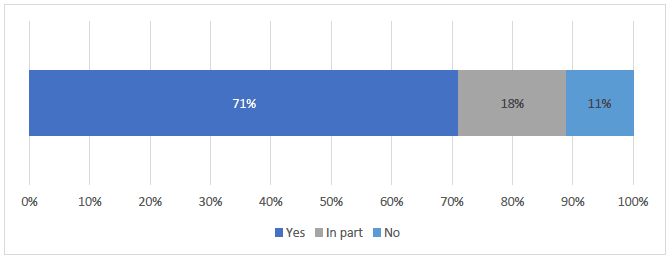
Base: 45
Nearly three quarters (71%) of respondents felt that yes it was clear who the Guidance was applicable to. Nearly a fifth (18%) felt that it was partly clear and the remainder felt that it was not clear.
Table 13. Clear guidance on who it is applicable to - follow-up
| Response option | Number answering open follow-up |
|---|---|
| Yes | 5 |
| No | 3 |
| In part | 5 |
Those answering 'Yes', variously: reiterated their agreement; commented that there was too much to take in; suggested that the competency of in-house teams should be checked; stated that it is useful to have guidance in one place; stated that the target groups are more aware of their duties.
Of the five respondents who answered, 'In part' and left comments, two thought the guidance is too focused on the social rented sector and more could be done to make it applicable to tenants of mid-market blocks, and private landlords.
An individual owner-occupier stated that the guidance should be clear that 'high rise' does not just apply to multi-storey flats, and that some converted Victorian townhouses are more than 18 metres high.
One organisation called for a national public register of residential buildings which are more than 18 metres high, and that the register should include the name of the accountable person.
Those who answered, 'No' highlighted perceived problems with mixed tenure, and suggested there was a need for greater clarity. These comments were from two individuals and a council.
"It is considered that owner occupiers should be specifically mentioned in the Summary part of the Guidance too in terms of their responsibilities in respect to common areas."
Fife Council Private Housing Standards Team
Question 18. Is the purpose of the Guidance clear for those expected to use it?
Figure 15. Whether the guidance is clear for those expected to use it
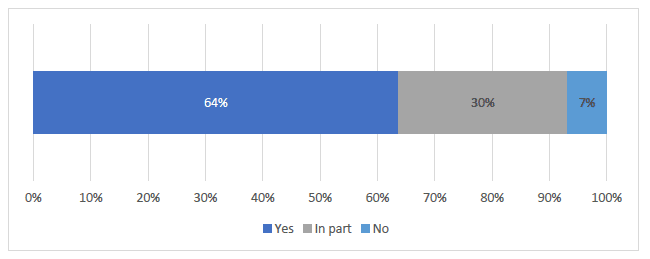
Base: 48
Nearly two thirds (64%) agreed the guidance was clear for those expected to use it. Around a third (30%) felt that it was 'in part' and the remainder felt it wasn't.
Table 14. Guidance clear - follow-up
| Response option | Number answering open follow-up |
|---|---|
| Yes | 2 |
| No | 3 |
| In part | 6 |
One of the two respondents answering, 'Yes' who chose to leave comments, suggested an easy to use 'hand held' version of the guidance would be useful; the other respondent confirmed their agreement.
Comments from those answering 'No' concerned perceived vagueness of the guidelines, indicators for people with additional support needs; and an assertion that private landlords see safety as not their direct responsibility'. These comments were provided by two organisations (a Local Authority and a Tenants Association) and one individual.
Respondents answering, 'In part' had concerns including: the availability of guidance for buildings above 26 storeys; more emphasis on why the guidance should be followed, and perceived 'grey areas' and areas 'open to interpretation or discretion'.
"While the guidance outlines its purpose is to assist building managers and those assessing fire risk in high-rise domestic buildings, it is unclear why it is important to follow the guidance. Rather, the guidance is quick to note that while those expected to use it are encouraged to do so, it is not mandatory. We believe people have a right to expect that the buildings they live, work, learn and recuperate in are safe. There should be clearer guidance on how those responsible for buildings can achieve a gold standard of fire safety."
Rockwool Ltd.
Question 19. Is it clear how the Guidance should be used in practice?
Figure 16. Is it clear how guidance should be used in practice
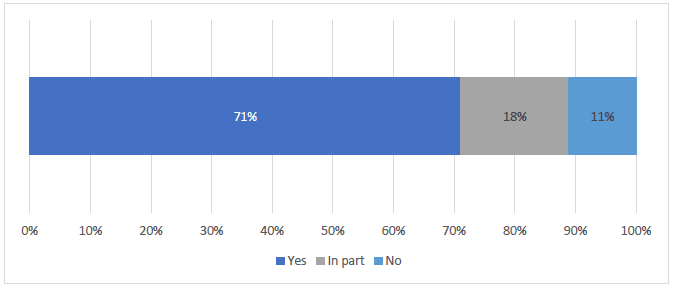
Base: 45
Nearly three quarters (71%) said that it is clear how the guidance should be used in practice. Just over a tenth (11%) responded that it wasn't clear.
Table 15. Clarity of how the guidance should be used - follow-up
| Response option | Number answering open follow-up |
|---|---|
| Yes | 4 |
| No | 3 |
| In part | 4 |
Those answering, 'Yes' left comments including how useful it is to have all guidance in one place; that the paper clearly sets out how the guidance should be used in practice; and perceived issues with interpretation.
Comments from those answering, 'No' included: a lack of definitive limits to the guidance, with a perceived danger of self-assessment where not appropriate; and perceived vagueness. These comments were from three organisations.
Those answering, 'In part' commented on vagueness, with particular mention of the paragraph 'Using this guidance'; there was a concern that there needs to be 'more education with landlords'.
"Use of the Guidance is not especially clear as the paragraph headed 'Using this Guidance' starts by hedging the Guidance with qualifications. As declared under Scope the Guidance is not mandatory. There is a case for saying that having due regard to the Guidance is essential (one step short of mandatory) and also saying under Use that due regard is qualified only by particular circumstances in particular buildings."
BAFE
Question 20. Is there further information that should be included?
Figure 17. Further information that should be included
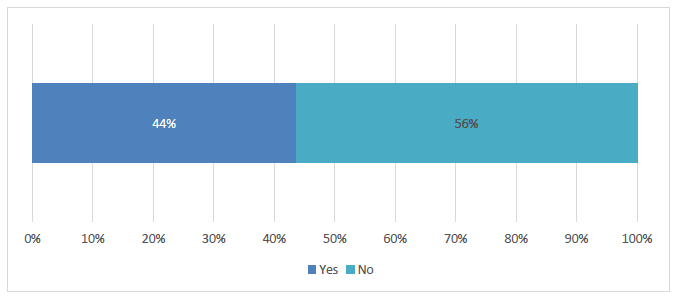
Base: 39
Nearly half (44%) felt that there was further information to include while the remainder felt that there wasn't (56%).
Table 16. Further information - follow-up
| Response option | Number of respondents answering open follow-up |
|---|---|
| Yes | 14 |
| No | 4 |
Respondents answering, 'Yes' who left comments had concerns about missing information which included:
- the inclusion of how repair/improvement works should be considered in relation to the guidance;
- smoke venting from stairs,
- examples of the consequences for owners/managers where they do not meet the requirements; and
- specific mention of gas and oxygen cylinders.
There were requests for more clarity around 'stay put' guidance, the role of local authorities, obligations of individual owner-occupiers and private landlords in mixed-tenure multi-storey blocks, and the limits of self-assessment.
One respondent who answered, 'No' suggested that there may be too much information in the guidance. They stated that the guidance could be more succinct.
"It is considered that further information on what happens when for example fire safety measures and systems are found to be in disrepair in blocks should be provided. What are the mechanisms for the various responsible parties to work together to repair them within appropriate timescales? In addition, what are the various problems that could arise in this regard and how might they be fixed?"
Fife Council Private Housing Standards Team
"Would be useful to provide basic comment on smoke venting from stairs and corridors under certain conditions as escape routes these need to be available for an extended time period due to the 'stay-put' policy. The guidance should also note that some fire detection in common areas is not provided to give warning but only to operated smoke control."
Fire Protection Association
Question 21. Please provide any further comments on this chapter in the box below.
Twelve respondents left further comments on this chapter.
Comments included: a reference to the dangers of combustible facades; gas safety and the need for cooperation to ensure access for checking appliances; a consideration of Fire Service access; the definition of 'specialist' as required for buildings higher than 60m; problems created by balconies incorporated into flats; and definitive policy around common foyers.
One respondent thought the guidance was a 'concise and usable document', whereas another suggested a requirement for 'condensed easy to understand information'.
"As with all communications surrounding fire prevention, it is important to for us to use a multi-channel approach to target a wide range of customers across multiple locations.
Face to face reassurance has also been extremely important for us, as this has given us the opportunity to speak to customers directly, find out more about their concerns and pass on the most up to date preventative advice from SFRS."
Wheatley Group
6.2 Fire safety design in high risk domestic buildings
Question 22. Do you think Fire Safety measures are clearly explained in the Guidance to those that own, factor, manage, give advice on and enforce standards in high-rise domestic buildings
Figure 18. Is guidance clear for those that factor, manage, give advice on and enforce standards
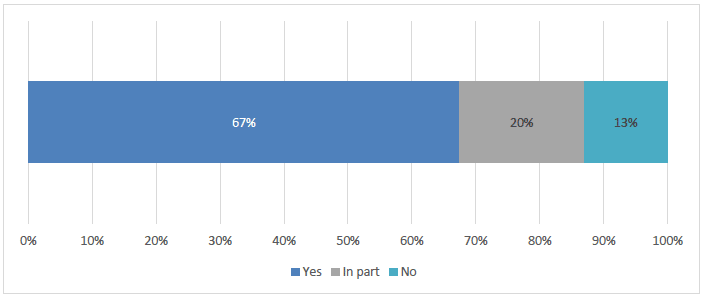
Base: 46
Just over two thirds (67%) agreed that the fire safety measures in the guidance are clearly explained for those that property factors, manage, give advice on and enforce standards in high rise domestic buildings. One fifth (20%) replied 'in part' and the remainder stated 'no'.
Table 17. Clear guidance - follow-up
| Response option | Number answering open follow-up |
|---|---|
| Yes | 4 |
| No | 3 |
| In part | 7 |
Those who answered, 'Yes' made comments including: guidance should complement the existing skills of those who own, factor, manage or give advice; guidance should be augmented with information sessions; and specific technical issues around compartmentalisation and asbestos materials.
One respondent who answered, 'No' referred to failures in fire safety design in England and Scotland, and the need for clarity in the guidance so those responsible for buildings can be confident that they have been constructed as designed. Another called for more clarity around responsibility.
Those answering, 'In part' had various suggestions including: introducing 'a single duty holder' stipulation for buildings in multiple ownership. There were calls for clarity around: 'stay put' policy; responsibilities of individuals and private landlords; and where to go for further guidance.
One respondent asked for more guidance regarding common areas. The guidance statement.
'it is undesirable for a common fire detection and alarm system to be provided' was queried by one organisation.
"There is an expectation that those who own, factor, manage, give advice on and enforce standards in high rise buildings should already be familiar and competent in this area. This guidance should therefore complement existing skills and understanding."
Local authority
Question 23. Do you think there is further information that should be included?
Figure 19. Should further information be included
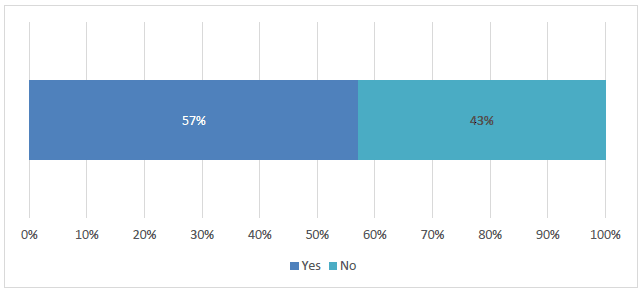
Base: 42
Just over half (57%) said that further information should be included in the guidance.
Some 19 respondents who selected 'yes' left comments.
One fire safety organisation queried whether 'stay put' advice has cost lives, suggesting that it might not be possible to include effective evacuation strategy in the guidance without just 'hedging bets', and that a better option would be to listen to SFRS advice.
Two respondents commented at length on the merits of multi-sensor fire detectors stating that they are the most appropriate form of fire detection and should be installed in all residences. Similarly, one respondent suggested that the guidance should have information relating the finite lifespan of smoke detectors. Another organisation asked for information regarding how those responsible for buildings can mitigate against smoke toxicity in the event of a fire.
There was a call for the guidance to include signposting to more detailed information, and a similar suggestion that local numbers for bodies to consult about fire safety should be in included in guidance.
One landlord asked for guidance from the Scottish Government relating to retrofit, life cycle replacements and improvements of existing blocks to ensure works to individual building elements do not change the original fire safety provisions within the blocks.
A local authority suggested a review/refinement process be added to the guidance to ensure it remains fit for purpose and new knowledge or understanding can be included.
Several respondents commented that guidance should be clearer on the safety responsibilities of private landlords, visitors and owner-occupiers of flats in buildings. There was particular reference to landlords with short term lets.
One organisation suggested a need for more clarity around the limits of the guidance, so users are able to understand when they have reached their limits in terms of assessing a hazard.
"More emphasis should maybe be placed on the fact that all owners in the building are equally responsible for fire safety as a way of highlighting to owners that they should ensure their flats are up to the same standards."
West Dunbartonshire Council
We would also agree that there is a need for regular SFRS homes safety visits. "Private landlords should have more responsibility for the care of their tenants & visitors for short term lets"
Individual - local authority tenant
Question 24. Please provide any further comments on this chapter in the box below.
Fifteen respondents provided further comments on this issue.
Two organisations stressed the importance of considering the design of non-residential areas in a building including waste storage facilities and car parking stating that these can be where fires start or are started deliberately and going on to highlight that these areas can also be essential for SFRS access.
One organisation drew attention to there being no mention of emergency lighting provision in the bullet points and the absence of any warning that inspection and competent maintenance of systems, doors, lighting and automatic fire suppression systems is essential; one individual had concerns regarding non slip floors where there are sprinklers, and reflective strips on stairs and stairwells.
A local authority suggested that ensuring tenants' and residents' concerns relating to fire safety design are heard and adequately investigated should be a priority; going on to suggest that both landlords and tenants should be clear on their responsibilities in relation to this area. They called for consideration to be given to the most appropriate methods of achieving this.
One respondent queried the accuracy of some of the wording in the guidance: suggesting that "appropriate to seek further opinion" should be clarified to who a further opinion should be sought from; and "Above the third floor . . ." could cause confusion in that third floors are at different heights on sloping sites. The respondent went on to disagree with the statement "A precautionary approach is contrary to the principles of risk assessment" and "rarely a need for fire exit signs".
There was a suggestion that alongside addressing issues of combustibility, regulations should take account of the creation of toxic smoke during fires and that product testing and classification should be introduced for toxicity, with limits set on usage which take account of the fatal dangers of toxic smoke in a fire.
"It is considered that a fire safety risk assessment should be a legal requirement for the common areas of high-rise blocks. Clarification should also be provided on how common insurance policies relate to this issue generally."
Fife Council Private Housing Standards Team
"With regard to the evacuation strategy it would be of benefit to fire and rescue services to be able to determine who is resident in the building and who may have special needs or disabilities which may hinder their evacuation and who may require particular assistance or measures to be in place This should be recorded as part of the risk assessment and advice, a copy of this should be available to those living in the building. Should this information not also be available to the F&RS as a minimum on arrival at a property?"
Trade body
6.3 Risk management - assessing the risk to persons
Question 25. Do you think the reasons for carrying out a Fire Risk Assessment in high-rise domestic buildings are clearly explained?
Figure 20. Clarity of reasons for fire risk assessment
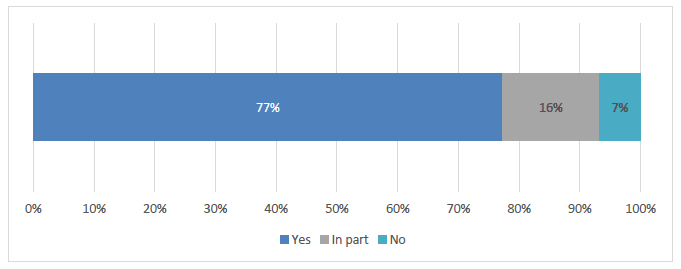
Base: 44
Just over three quarters (77%) of respondents felt that the reasons for carrying out a fire risk assessment in high rise domestic buildings were clear. A small minority selected 'in part' or 'no'.
Table 18. Clarity of reasons - follow-up
| Response option | Number answering open follow-up |
|---|---|
| Yes | 5 |
| No | 2 |
| In part | 2 |
Those answering, 'Yes' either simply confirmed their agreement or qualified their response. One national organisation was concerned that fire risk assessments could be carried out by a 'non-competent' person.
There was a call for more guidance around those who would be unable to self-evacuate, highlighting the issues faced by those with mobility problems when lifts are out of operation.
One local authority thought the reasons are equally applicable to medium and low-rise multi-occupancy buildings.
Both respondents answering, 'No' were tenants commenting that they had received little fire safety information.
One of those answering, 'In part' commented on a need to 'emphasise the benefits of assessment in owner occupied, converted buildings too, not just traditional multi storey flats'; the other was concerned that there are 'eight key points of risk management in the guidance, but only one of them explains the reason or purpose for assessing the risk from fire'.
"Reasons are also applicable to medium and low-rise multi-occupancy buildings"
Institution of Gas Engineers and Managers
"The use of third party approved providers for all fire safety assessment, inspection and maintenance functions is supported.
There should be more guidance about people who may not be able to self-evacuate. People with mobility impairments may be able to access their flats using the lifts but this may not be available in case of fire, without fire service assistance."
Fire Protection Association
Question 26. Do you think how to carry out a Fire Risk Assessment in high-rise domestic buildings is clearly explained in the 7-step methodology for assessing fire risk in the Guidance?
Figure 21. Is fire assessment method clearly explained in 7 step methodology
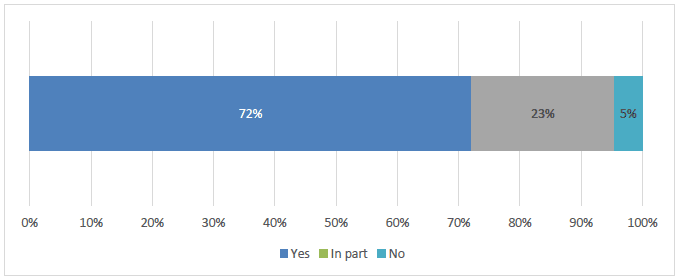
Base: 43
Nearly three quarters (72%) of respondents felt the guidance on how to carry out a fire risk assessment was clearly explained. Close to a quarter (23%) felt it was 'in part' and the very small remainder thought it wasn't clear.
Table 19. 7 step methodology -follow-up
| Response option | Number answering open follow-up |
|---|---|
| Yes | 11 |
| No | 1 |
| In part | 5 |
The overarching concern for those answering, 'Yes' was around the competence of individuals carrying out risk assessments. Respondents would like to see a nationally agreed recognised qualification for fire risk assessors.
One local authority stated that they would use the guidance to monitor the external consultants who perform their risk assessments. One respondent suggested that because characteristics of fires in multi-storey blocks can be different to other building types, it is particularly important that assessors understand their specific fire safety requirements.
One housing association and one local authority tenant thought the methodology was too generic.
One owner-occupier responding, 'In part' had specific concerns covering: potential (rather than current at the time of the risk assessment) sources of ignition e.g. 'contractors' items'; the possible lack of fire stopping between floors; external cladding; and that the assessment should identify any elements of the buildings safety system which may be missing or non-functioning.
An organisation responding, 'In part' highlighted that the guidance: makes no reference as to how to decide if existing fire safety measures are adequate; mentions travels distances without giving any context as to what an acceptable travel distance is; and stated that a fire risk assessment should not be an assessment of whether something is adequate or not (which is a yes/no answer), but an assessment of the risk level.
One organisation supported the need for risk assessments 'as understanding the needs of residents is important in designing risk management measures' they went on to stress that if councils were to be asked to undertake any work, then, if not already funded for such measures, that funding would need to be made available.
It is considered that referral to an outside specialist could be a preferred choice. It is important that this sector is properly regulated. It is important that fire risk assessors have the required competence in the particular field of high-rise blocks, and they can provide competent, properly reasoned and site-specific assessments.
Fife Council Private Housing Standards Team
"It is useful for the guidance to include suggested methodology for carrying out a fire risk assessment, but it does also make clear that this is just one example and that others can be used if deemed to be more appropriate."
Chartered Institute of Housing Scotland
"Scope of fire risk assessment should include reference to utilities. In particular the risk of fire from the gas supply. It must take account of the ventilation of service ducts and gas meter rooms."
Institution of Gas Engineers and Managers
Question 27. Do you think there is other information that should be included?
Figure 22. Further information necessary
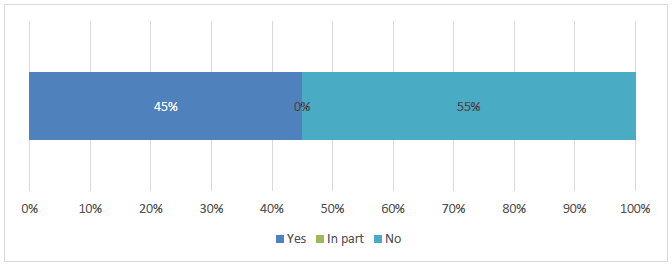
Base: 40
Nearly half the respondents (45%) felt that further information should be included.
There were 17 further comments for this section.
Respondent requests for information that could be added to the guidance include: location of first aid trained personnel; details for assessing blocks with wooden balconies including their particular evacuation requirements; and more emphasis on support available for assessors.
There were several suggestions around risk assessments including: two organisations which highlighted the need to keep records and documentation supporting assessments, and that these should be kept off-site; one organisation would like to see samples of risk assessments included in the guidance; and suggestions that that further information on how to organise and act on findings of risk assessment would be useful.
Two nationwide organisations called for details of closer cooperation with utilities providers - particularly gas.
There were two suggestions highlighting a perceived need for clearer specification of the duties of private landlords and owner-occupiers in multi-tenure blocks.
One organisation commented that It would be useful to have references to legislation, but in doing so the language used needs to be understandable to all that have access to the guidance.
"The need to keep suitable documentation and records to support the assessment of risk and management of the fire safety of the building should be included. These include a copy of the risk assessment, design information such as as-built drawings and the fire strategy document, inspection and maintenance records, installation and commissioning certificates (active and passive systems) and similar."
Fire Protection Association
Question 28. If you own, factor, manage, give advice on and enforce standards in high-rise domestic buildings: is there a process in place for the assessment and removal of items left in common areas.
Figure 23. Process in place for assessment and removal of items left in common areas (those that own, factor, manage, give advice on and enforce standards in high rise domestic buildings)
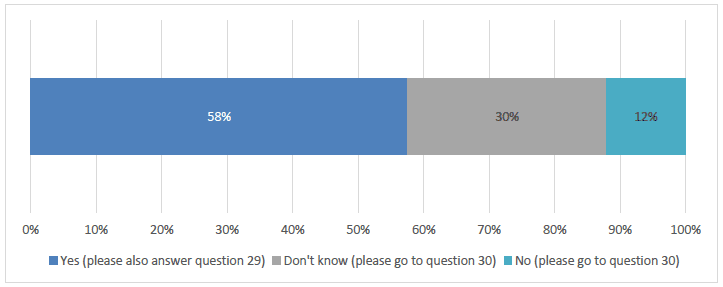
Base: 33
With regard those that own, factor, manage and give advice on and enforce standards in high rise domestic buildings, over half (58%) said that there was a process in place for the assessment and removal of items left in common areas. Nearly a third (30%) didn't know if a process existed 12% stated there wasn't a process.
Table 20. Process- follow-up
| Response option | Number answering open follow-up |
|---|---|
| Yes | 7 |
| No | 0 |
| Don't know | 0 |
Organisations left comments summarising their processes for managing items left in common areas. Processes included: checking areas four times daily; engaging with tenants, and removing items after a set period of time if necessary.
Two organisations highlighted difficulties; one had concerns about items placed in common areas for 'decorative purposes', and mobility scooters; the other stated that the process can sometimes take longer to fully action and implement than would be ideal.
"Should items be left in common areas the council will engage with tenants or residents responsible to ensure it's removed as quickly as possible. If tenants or residents fail to remove it within a set period of time, the council will take action to remove it and dispose of the items."
Local authority
Question 29. If you answered yes to question 28: do you have confidence that the process works in practice?
Figure 24. Confidence that process works in practice
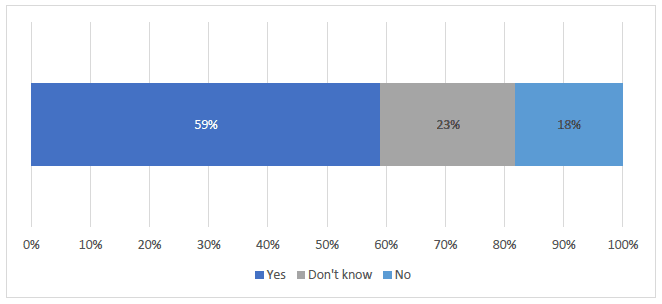
Base: 22
Just over half (59%) felt that the process in place works, nearly a quarter (23%) didn't know and the remainder felt it doesn't work.
Table 21. Process works - follow-up
| Response option | Number answering open follow-up |
|---|---|
| Yes | 4 |
| No | 3 |
| Don't know | 2 |
Two of the four organisations answering, 'Yes' qualified their response by stating that the process sometimes takes longer than they would like. The other two which were both local authorities reiterated that their processes work; highlighting that 'sweeps' are made regularly and that they are monitored.
Two organisations answering, 'No' pointed out that success is subject to enforcement action which in one case can be delayed by bureaucracy.
One housing association reported different levels of confidence for each of its units, and suggested that 'clearer legality of enforcement and removal powers would be required'.
"Regular inspections by officers and enforcement of non-compliance proves effective in ensuring both of the clearing of items and reducing persistent offenders."
Local authority
"The process works. Sweeps of buildings are carried out and any items that shouldn't be there are acted upon. It is monitored that the sweeps are carried out also."
West Dunbartonshire Council
Question 30. Please provide any further comments on this chapter in the box below.
Six respondents left further comments on this chapter.
One would like the Fire Risk Assessment to be 5 steps to match existing FRA methodology, and the inclusion of a risk matrix and industry-standard definitions for assessing fire risk.
There was a suggestion that the competence of fire risk assessors is critical and a way of checking their credentials is to check their professional indemnity insurance.
Reference was made to maintenance of fire mains and fire-fighting lifts in the guidance, with a respondent asking for clarity about who would verify the maintenance.
There was a call to make removal of obstructions in common areas compulsory, alongside fire risk assessments for these areas, and similarly that installation of decorative features should be discouraged.
"Risk management also applies to lower rise properties that do not meet the definition of high rise. Issues can arise for example where 4/5 storey blocks etc have possibly had a factor in place in the past but thereafter owners/landlords have not worked together to manage the risk in common areas.
This should also be considered as part of the ongoing review to strengthen fire safety."
Fife Council Private Housing Standards Team
6.4 Risk management - preventing fires
Question 31. Do you think it is clearly explained how to prevent the impact of fires in high-rise domestic buildings?
Figure 25. Whether how to prevent the impact of fires is clear
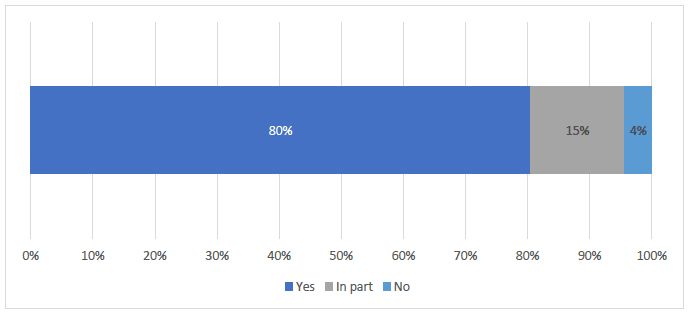
Base: 46
The majority of respondents (80%) felt that the guidance clearly explains how to prevent the impact of fires in high rise domestic buildings. A small percentage (15%) felt that it did 'in part' and the very small remainder (4%) felt it didn't.
Table 22. Preventing impact - follow-up
| Response option | Number answering open follow-up |
|---|---|
| Yes | 6 |
| No | 0 |
| In part | 4 |
Those answering, 'Yes' generally left comments in support of the guidance.
A tenant association and a local authority both praised advice and information about preventing fires, but they stated that advice about preventing the impact of fires lacked clarity; they commented that preventing fires and preventing impact of fires are separate issues.
Local authorities commented that they found advice about the importance of containing fires in their place of origin and maintaining the integrity of common areas helpful; whereas two individuals answering, 'In part' called for greater emphasis and more information about removing items from common areas.
One manufacturer highlighted that the use combustible materials for facades is permissible in Scotland, and called for public access to information concerning the characteristics of materials used in the building they are living in or considering living in.[1]
"The need to respond to recalls for electrical appliances should be mentioned"
Maxwellton Court Tenant Association (Secretary) Tenant Renfrewshire Council
"The guidance clearly identifies the importance of containing the fire in its place of origin and maintaining the integrity of common areas."
Local authority
Question 32. Do you think it is clearly explained how to reduce the impact of fires in high-rise domestic buildings?
Figure 26. Is how to reduce the impact of fires clearly explained
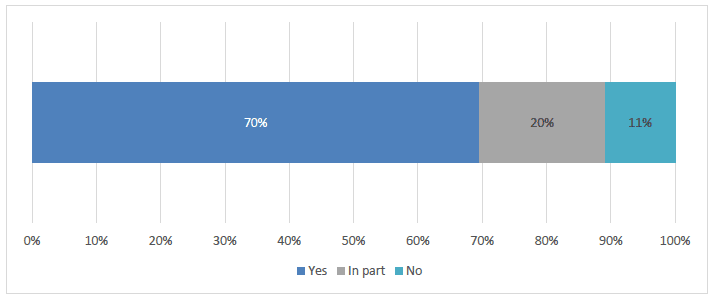
Base: 46
Nearly three quarters (70%) felt that the guidance clearly explains how to reduce the impact of fires in high rise domestic buildings. A fifth (20%) felt it did partly, and the rest (11%) felt it didn't.
Table 23. Reduce impact - follow-up
| Response option | Number answering open follow-up |
|---|---|
| Yes | 3 |
| No | 2 |
| In part | 5 |
Those answering, 'In part' and those answering, 'Yes' had similar issues.
One local authority and one national trade organisation drew attention to a possible error in guidance for electrical testing 'The electrical testing cycle is stated incorrectly as every 10 years - BS 7671 states it should be every 5 years', with the trade organisation going on to say that testing intervals for privately owned properties in high risk residential buildings should be maximum five years.
One local authority commented that it had no detailed information about the condition of electrical installations in owner-occupied flats.
Two local authorities called for 'zero tolerance' towards items in common areas - regardless of combustibility, reasoning that any item in common areas may prohibit escape for those evacuating the building or restrict entry for emergency personnel trying to gain entry.
"The section clearly and accurately explains how certain 'human behaviours' could reduce the impact of fires in high rise buildings. However, this can only be achieved through the application of a 'zero tolerance' policy. Regardless of how combustible items are defined as, keeping any item in common areas may prohibit escape for those evacuating the building or restrict entry for emergency personnel trying to gain entry."
Local authority
Question 33. Do you think there is further information that should be included?
Figure 27. Any further information to be included
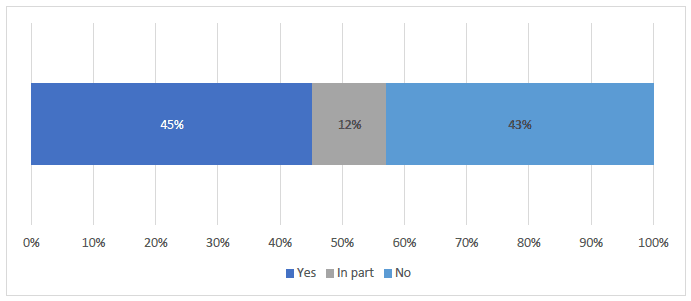
Base: 42
Close to half (50%) the respondents felt that the response should include more information.
Table 24. Further information -follow-up
| Response option | Number answering open follow-up |
|---|---|
| Yes | 16 |
| No | 2 |
| In part | 3 |
Several organisations asked for examples of best practice to be expanded and for case studies to be included in the guidance.
Two respondents said their housing association stated that smoking in homes and common areas should be discouraged; while a local authority called for a total ban on smoking (to include e-cigarettes) within buildings.
Several organisations remarked on the difficulties of keeping common areas clear.
One organisation and one individual had concerns about combustible facades.
There was one reference to relatively new electrical standards by a trade association; while an individual highlighted potential problems with recalled appliances; and a local authority suggested guidance around not leaving cookers unattended.
A tenants' association suggested that there should be a requirement to ensure that communication with the concierge is functional.
"It should be legislated that companies cannot carry out works within flats that affect the common fabric of the building and in turn affect the fire safety of the building. Communication companies especially can drill holes etc. into walls affecting fire safety measures without having had to seek a permit to work. Permit to work in all instances should be made mandatory and penalties should be in place for companies who do not adhere to this."
West Dunbartonshire Council
Question 34. Please provide any further comments on this chapter in the box below.
Nine respondents left further comments on the chapter.
Two local authorities and one housing association commented that they would like 'zero tolerance' policy to be the default; one local authority stated that this was SFRS policy and highlighted a lack of clarity in legislative power to support this; another local authority asked who would be responsible for enforcing policy.
A tenants' association which was happy that the guidance commended landlords for providing scooter charging stations outside buildings; went on to suggest that 'scooters, prams, bicycles etc can be in 'common areas' as long as they don't cause an obstruction'.
A local authority suggested that the guidance should be reviewed to ensure that it remains up to date, taking account of advancements in all aspects of building design and use. Another local authority stated that the guidance could apply to blocks with fewer than six storeys.
One organisation suggested that guidance around prevention of fire is set out well but does not address how to reduce the impact of fire in a high rise, i.e. how to limit the damage/spread post-ignition. They suggested that maintenance and integrity of life safety systems e.g. smoke extractors and fire doors is a key part of this.
6.5 Risk management - physical fire safety measures
Question 35. Do you think the physical fire safety measures in high-rise domestice buildings are clearly explained?
Figure 28. Are physical fire safety measures clearly explained
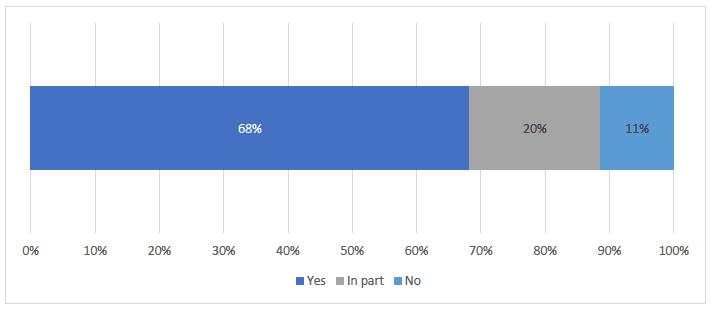
Base: 44
Just over two thirds (68%) of respondents agreed that the physical fire safety measures are clearly explained. A fifth (20%) felt they were 'in part' and a small percentage (11%) felt they weren't.
Table 25. Physical fire safety measures -follow-up
| Response option | Number answering open follow-up |
|---|---|
| Yes | 0 |
| No | 2 |
| In part | 7 |
The two respondents answering, 'No' were individuals commenting on the situation in their residences.
A local authority tenant answering, 'In part' stated that more should be done about the responsibility of owners to their tenants and to their neighbours.
Some respondents suggested that the guidance takes for granted that the target audience would have a good level of understanding of general fire safety principles; for example, that a landlord or managing agent/factor knows what constitutes 60 minutes or 120 minutes fire resistance, or what constitutes non-combustible, or how to identify a fire door.
Two organisations left comments which referred to exterior cladding, including the following.
"We are concerned that the guidance and objectives of this consultation will be undermined by the Scottish Government's confirmation that building regulations will continue to permit the use of combustible cladding and insulation on the façades of all buildings in Scotland"
Rockwool
Question 36. Do you think there is further information that should be included?
Figure 29. Further information needed
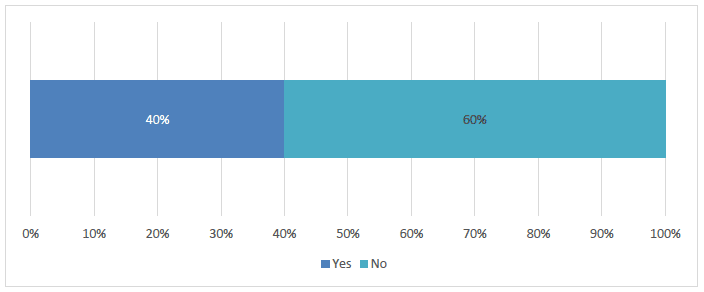
Base: 40
Nearly two thirds (60%) felt that there was no need for further information to be included.
Table 26. Further information - follow-up
| Response option | Number answering open follow-up |
|---|---|
| Yes | 10 |
| No | 5 |
| Not Answered | 2 |
Those that answered 'No' generally felt that the guidance was very comprehensive and is consistent with current best practice. Although one mentioned that guidance relating to the use of portable gas or paraffin heaters would be helpful and another suggested that landlords may have some thoughts around the guidance.
Those that did not select an answer stated that providing warning notices on fire prevention devices would be useful to prevent vandalism. Information around construction and things that compromise fire safety was requested.
The respondents that answered 'Yes' felt that the following additional information could be included.
Fire cabling systems were mentioned particularly those in common or escape stair areas in relation to ensuring cables installed are suitably classified. Fire stopping should also be considered where cables breach fire compartments and separating walls and floors. It was also mentioned that with regards to cable entrapment for fire fighters, reference to 'Requirements for Electrical Installations' should be included.
One individual mentioned that any information that could potentially save someone's life should be included. Another mentioned links to sources that might be helpful and any photos or imagery that might help support the message.
One respondent said that the importance of ventilation should be highlighted in connection with the build up of flammable gas/the escape of gas. They also mentioned that cooperation between the Gas Transporter and Meter Asset Manager with the building owner/fire safety office would be key.
There remained a concern around assumed fire safety systems and it was felt that residents should be made aware if a system does not exist or if it is malfunctioning.
One organisation mentioned that it is not clear who the person responsible is. Another stated that they would support having the details of a key named contact/duty holder who is responsible for asset management and accountable for all activities within the building. This will make communication easier and quicker if a building safety matter arises.
Also including a section for those with disabilities was thought to be useful.
"Information on construction and whether the methods compromise fire safety, whether our buildings have been checked or should be checked."
Individual
"No, the information provided is consistent with current best practice."
Local Authority
Question 37. Please provide any further comments on this chapter in the box below.
There were 7 respondents that left further comments on this chapter.
One respondent had concerns around the Fire Detection and Alarm Systems section as they noted some inconsistencies and wanted to raise the use of long-life battery tamper proof devices.
Another respondent stated that this section within the guidance is too wordy and mentioned that this may put landlords off reading it.
It was suggested by one organisation that it might be good to involve tenants who are interested or knowledgeable about their building in the inspections.
One respondent had queries around the lifespan and expiry of products within buildings and how this would be managed.
It was felt by one respondent that information notes on pages 48-50 should be shared with all residents who live in high rise domestic buildings. Another noted that physical fire safety measures and risk assessments also apply to blocks of for example, 4 or 5 storeys.
One organisation made multiple comments on the chapter but welcomed the guidance references to ducted heating, ventilation, air conditioning systems and fire stopping. They mentioned a few things in connection with third parties. This was around adding third party certification of products as a means of due diligence and said that third party certification of specialists in the testing of risers is being developed and that a reference to this might be good to include. They also mentioned that fire resistant doors should be installed by relevant people to ensure the efficacy of the doors as there have been occasions where poor fitting has undermined how they perform. Experience has also pointed to lights on escape routes as being a common failure and wanted to ensure regular testing and maintenance. According to them on page 59 it is unclear where the suggested reference to "paragraphs 38 and 39" is. There was also mention that additional commentary may be required in relation to this and around the prevention of external fire spread via balconies or trellises. They want to make sure that it is clear in the guidance that testing and maintenance is high priority.
"The section within the guidance is too wordy (18 pages long). PRS landlords will be put off from participating in the consultation."
Local Authority
"Involve Residents interested/knowledgeable about their building in Inspections."
Organisation
6.6 Risk management - ongoing control
Question 38. Do you think there is further information that should be included?
Figure 30. Risk - further information required
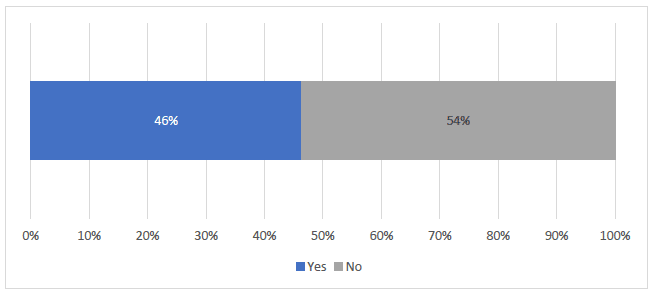
Base: 41
Just under half (46%) of respondents felt that more information should be included.
Table 27. Further information - follow-up
| Response option | Number answering open follow-up |
|---|---|
| Yes | 15 |
| No | 2 |
The respondents that answered 'yes' suggested the following information be included or clarified within the guidance.
It was suggested that a best practice management system with strict controls be introduced and be used for things such as building work and alterations and a model best practice permit system for things such as for DIY, electrical installations. Another mentioned using third party accredited persons when work is required to be carried out.
One respondent suggested that fire safety should be checked every 11 months as with gas appliances. Another stated that there must also be a duty to cooperate between the building owner, the Gas Transporter and Meter Asset Manager.
Additional support for PRS tenants was mentioned.
There were a few mentions of 'responsibilities' within the feedback. Two respondents stated that collective responsibility of all residents for fire safety should be highlighted. It was understood that this may be a challenge as it depends on how tenants view collective responsibility, but it could be part of their sign-up agreement or charter or part of their settling in visits. One respondent mentioned that responsibilities for landlords, especially factors would be useful. Another stated that the responsibility for fire risk management is not clear and that fire assessments should be mandatory, not optional and that the factor should have the duty to carry out and enforce the resulting findings. One organisation requested clarification whose responsibility it would be for dealing with issues in common areas if it was an MSF block and if there was no Housing Officer.
Advisory notices should be utilised including information such as not to using the lifts during fire alarms and leave safely without panic.
One respondent mentioned that the chapter gives a good overview indicating roles and responsibilities but that it would be useful to define in the tenant information handbook, specific testing and maintenance duties that the tenant could/should undertake in order to limit fire hazards (boiler, white goods, smoke detection) and what should normally be done.
A few mentioned that contractors should be monitored properly and any work carried out should have a building warrant or sufficient approved alternative measures in place.
There were also requests for regular survey findings, more information about building construction and the implications of risk.
One respondent mentioned that information on preparing for emergencies should include plans, information boxes and the provision of info for fire fighters.
"Our view is that fire safety in high rise blocks, is the responsibility of each and every tenant and resident who lives there. We would like to see some emphasis placed on the collective responsibilities of all tenants & residents in order to encourage people to see beyond their own individual properties and experiences."
Maxwellton Court Tenant Association (Secretary) Tenant Renfrewshire Council
"There should be a best practice management system for controlling building work and alterations carried out within high risk residential buildings - residents should only be permitted to undertake work and strict controls should be applied in this type of building - DIY work in particular to electrical installations should be prohibited- perhaps a model best practice permit system should be given in the guidance."
Organisation
Question 39. Please provide any further comments on this chapter in the box below.
There were 14 further comments left by respondents on this chapter.
More emphasis could be given to the benefit of having a common alarm system as an added safety measure.
Respondents mentioned the importance of inspections and having a qualified professional to carry them out. One organisation stated that they welcome the importance placed on inspection, testing and maintenance of fire safety systems and equipment. Following significant alteration or repairs a qualified fire risk assessor should inspect the work. Documentary evidence including the spec of the materials should be provided to the assessor along with certificates, photographs and videos where appropriate. Another respondent mentioned that utility providers should notify landlords/owners/factors in advance of proposed work, that the providers maintain compartmentalisation at all stages of the works and that the fire compartmentalisation reinstatements are undertaken by third party accredited contractors.
One of the respondents suggested that it would be good to include residents in inspections. Another mentioned that landlords must discuss with their tenants the rules and regulations which are important to keep them safe in their homes.
The topics of fire doors was also raised. One tenant mentioned that they still have no working fire door in their kitchen and are concerned about it. One of the organisations stated they agree with the guidance that fire doors should be routinely checked and requested that the Scottish Government review the frequency of these checks to ensure proportionate to the risk. Again, it was stated that these checks should be performed by a qualified professional.
There was a suggestion that landlords/owners can carry out alterations or building works without informing the local authority as it can cause delays.
One respondent strongly supported the requirement of appointing someone responsible for fire safety in the building.
"It was felt that maybe more emphasis could be given to the benefit of having a common alarm system as an added safety measure and not just install one in instances where it is felt that fire safety in the block may not be as good as it should."
West Dunbartonshire Council
"Installation and completion certificates should be obtained for all active and passive protection installations along with supporting evidence where possible such as photographs."
Fire Protection Association
Question 40. Do you think information on physical fire safety is useful to have in the Guidance?
Figure 31. Useful to have information on physical fire safety measures in the guidance
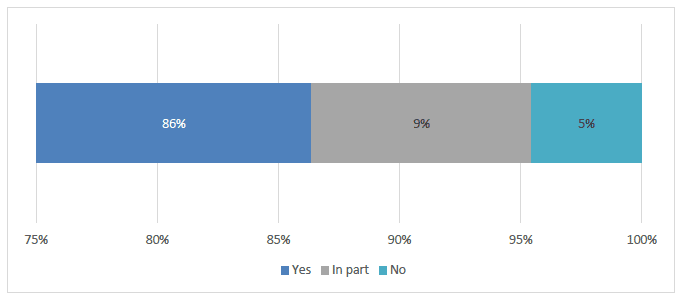
Base: 44
The majority (86%) felt that it was useful information to have in the guidance. Nearly a tenth (9%) felt it was 'in part' and a very small proportion (5%) felt it wasn't useful.
Table 28. Physical fire safety guidance - follow-up
| Response option | Number answering open follow-up |
|---|---|
| Yes | 9 |
| No | 1 |
| In part | 2 |
The majority of respondents who left comments felt that it was useful information to have in the guidance.
Most that selected 'yes' thought that the information that was listed and explained was very useful and important. They felt that it provides clarification of what would be assessed, what parties should and should not be doing, details legal rights, responsibilities and implications of breach of law and provides good information for all parties to be aware of. Although most selected 'yes' there were some further comments on this topic.
One tenant requested that lay person language would be helpful.
Two companies mentioned that it is good that high importance is being placed on this topic and that it is great that the information and guidelines will be constantly reappraised and updated. Suggestion was made to perhaps point readers to the online version to make sure they access the most up to date guidance.
Three respondents mentioned CDM regulations and if they should be included. One suggested that there should be a new section included stating who is responsible as the 'client' in each case.
It was suggested by two companies that there should be stronger penalties in place for regulation breaches and that it might be worth highlighting existing penalties and including prosecution examples.
One respondent would like clarification on the role of building standards to be included and that the guidance should emphasize that building owners are responsible for meeting the required building regulations.
"With regard to breaches of statutory regulation there should be stronger penalties available to impose on those found to have contravened such regulations in high risk residential buildings and others - how many persons are actually prosecuted for this type of breach in Scotland - probably very few!"
Organisation
"This is useful as it indicates that issues regarding high rise flats are being considered at a higher level and will be constantly reappraised."
Tenant and Residents Networks - Central Scotland Region 4
Question 41. Is the information on the legislation in this section of the guidance clear?
Figure 32. Information on legislation clear
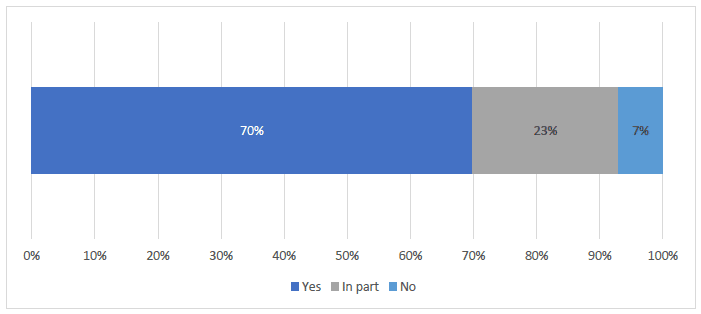
Base: 43
Close to three quarters (70%) of respondents felt the information on legislation was clear, nearly a quarter (23%) felt it was partly and a small minority (7%) thought it wasn't.
Table 29. Information on legislation - follow-up
| Response option | Number answering open follow-up |
|---|---|
| Yes | 2 |
| No | 2 |
| In part | 7 |
Those that answered 'no' and 'in part' left the following comments and suggestions.
One respondent was unsure where the legislation was and where the resident copy was.
One individual mentioned that translation to lay person language would be helpful.
Other respondents mentioned some areas that were unclear. These included making the duty to cooperate with the guidance more explicit, stating the cost implications, having a deterrent to prevent unauthorised alterations, highlighting resourcing requirement for enforcement activities, reviewing the Tenements Act with provision of structures and management processes.
One organisation continued to have concerns about the Government allowing the use of combustible cladding and insulation.
"In part. The guidance highlights the range of powers available to local authorities under the Building (Scotland) Act 2003, however barriers do currently exist in applying enforcement practices within these. Further review of this area may be required to ensure that if it is identified within the new guidance it can be actively enforced."
Organisation
"However, there does not appear to be an explicit duty to cooperate placed on the building owner and the Gas Transporter/Meter Asset Manager. This should be emphasised within the guidance."
institution of Gas Engineers and Managers (IGEM)
6.7 Using a fire risk assessment
Question 42. Do you think that those responsible for carrying out a fire risk assessment will find the included Fire Risk Assessment template easy to use to carry out an effective assessment?
Figure 33. Is fire risk assessment template easy to use
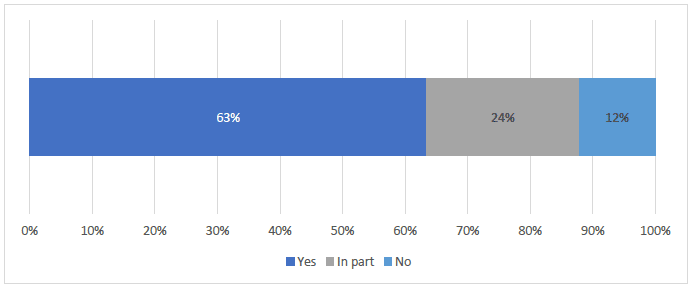
Base: 41
Nearly two thirds (63%) thought that the template would be easy to use. Just over a tenth (12%) felt it wouldn't be easy to use and nearly a quarter (24%) felt it was 'in part'.
Table 30. Template easy to use - Follow-up
| Response option | Number answering open follow-up |
|---|---|
| Yes | 6 |
| No | 3 |
| In part | 3 |
There were 12 responses to this question.
There were mixed feelings towards the suggested template. The respondents that selected 'yes' stated that the template was easy to use, helpful and clear with good detail. They mentioned that it was useful for training and quality assurance and would ensure things aren't overlooked. Some organisations commented that they already have templates in place but that this one aligns closely.
Of those that selected 'no' or 'in part' one of the respondents said that the template was incomplete and confusing, and others had suggestions on where improvements could be made.
The following suggestions were made for the improvement of the template/process;
6.7.1 Professional assessment by someone accredited
It was felt by one organisation that a professional assessment should be carried out by an accredited professional. They stated that landlords and organisations should not be left to manage their own templates. They said that the template should be removed, and an alternative solution put in place. Another organisation agreed that a simple template is inappropriate and recommended it be removed in favour of a comprehensive assessment by someone qualified.
6.7.2 Format/question review
Consider if tick box is the best approach
Leave room for comments
Ensure wording is clear for each question
Make sure two-part questions are split out
6.7.3 Inclusions
A completed template as an example
Matrix guidance
Section for fire safety documents/record availability
Section to identify whether this is a re-inspection after the initial fire risk assessment. On P84 if fire suppression installations are provided there should be an additional question about whether they are maintained.
It was mentioned that some installations do not have fire classification reports making it difficult to assess against certifications. Also no current requirement for a building passport.
"It is easy to use and provides a common standard for all."
West Dunbartonshire Council
"No - we need a higher standard than the Fire Risk Assessment template provided in this guidance. Competent and professional assessments of high-rise buildings are required and should be carried out with professionals holding third party accreditation. There should not be an option for organisations, building owners, managers to use their own templates. The current template should be removed from the guidance and an improved solution put forward by Scottish Government."
Organisation
Question 43. Can you suggest ways to let people know this Guidance is available once it is published.
Table 31. Ways to let people know the guidance is available
| Medium | Suggestions |
|---|---|
| National/widespread advertising | 9 |
| Property factors/letting agents/owners | 8 |
| Social media | 6 |
| Mail/Council tax/rent letters | 6 |
| TV campaign | 5 |
| Local or national news/newspaper | 5 |
| Gov and council websites | 4 |
| Leaflets | 4 |
| Events/Roadshows | 4 |
| Radio | 3 |
| Residents groups and organisations | 3 |
| Common area notices | 3 |
| Posters | 2 |
| 1 | |
| Billboards | 1 |
| On buses | 1 |
| Newsletter | 1 |
| RTOs | 1 |
| Word of mouth | 1 |
| Magazines | 1 |
| Welcome packs | 1 |
The most mentioned methods of making people aware of the guidance were national/widespread advertising, through property factors/letting agents/owners.
There were 37 further comments in response to this question.
The following were suggested as ideas of ways to let people know about the guidance. The key ideas below were mentioned multiple times.
A national widespread campaign appeared to be the most popular options closely followed by information distributed through factors, letting agents and landlords. After this, letters, social media, tv and news were other suggested options. It was suggested by most that a multi-media approach would be best.
"Country wide advertising campaign. Social media campaign. Leaflet drops to high rise. Opportunities for different languages. Local events."
Anonymous
"Send a letter to all High-rise dwellers but also have a TV, poster and newspaper campaign - it might be costly but will save lives in the longer term, social media should also be used."
Individual tenant
Question 44. Will this Guidance be straightforward to use by those that own, factor, manage, give advice on and enforce standards in high-rise domestic properties?
Figure 34. Guidance straightforward to use by those that own, factor, manage, give advice on and enforce standards in high rise domestic buildings
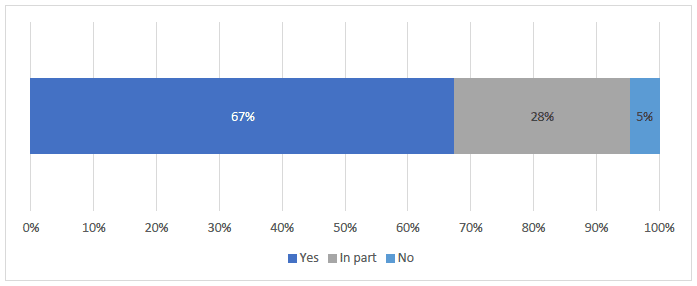
Base: 43
Just over two thirds (67%) thought that this guidance will be straightforward to use. Over a quarter (28%) felt it was 'in part'.
Table 32. Guidance straightforward follow-up
| Response option | Number answering open follow-up |
|---|---|
| Yes | 6 |
| No | 1 |
| In part | 6 |
This question received mixed responses. Those that selected 'yes' reported that the guidance would be straightforward to use for those that manage, give advice on and enforce standards in high rise domestic buildings. One reported that the document was well structured and another mentioned that those using it should be aware of any new guidance being published.
The remainder of organisations selecting 'no' or 'in part' said that more clarity around the approach to managing/enforcing housekeeping in common areas is required and suggested that information for owners needs to be simplified.
One organisation raised that how straightforward the guidance is to use would depend on how those using the guidance would be regulated to see if they understand and have implemented it correctly.
Two organisations questioned whether it would be possible to put a legal framework in place regarding fire risk in common areas.
"There are discrepancies within the document which we have raised ion previous sections. In addition, it will still to be challenging to apply the Guidance in full due properties being factored."
Local authority
"Depends on how landlords are regulated in the use of the Guidance."
Local authority
Question 45. Do you think the content is clear and easy to understand?
Figure 35. Content is clear and easy to understand
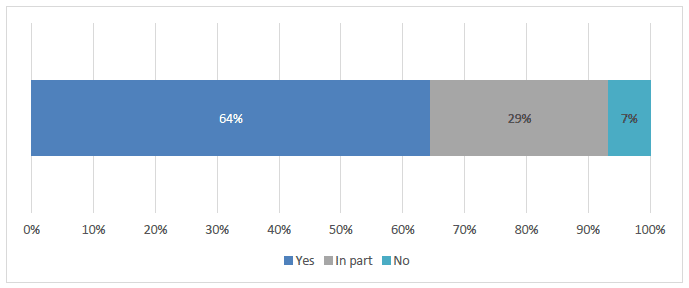
Base: 45
Close to two thirds (64%) felt the content was clear and easy to understand. A very small proportion felt it wasn't (7%) and just over a quarter (29%) felt it was 'in part'.
Table 33. Content is clear - follow-up
| Response option | Number answering open follow-up |
|---|---|
| Yes | 2 |
| No | 1 |
| In part | 7 |
Ten comments were left under this section.
Generally the document was perceived as being clear and easy to understand. However, all respondents that selected 'in part' did feel that it was a little too wordy in places potentially due to the technical nature of the topic.
"It will be important that the guidance is followed by all stakeholders in practice. Our members have indicated that the guidance is likely to be clear and easy to understand to the target audience."
Organisation
"There is quite a bit of technical language and jargon included in the content however we are conscious of the fact that this guidance is primarily aimed at those who own, factor, manage, give advice on and enforce standards in high rise domestic buildings. As a committee, we felt it was important to feed into this critical consultation from the perspective of tenants and residents, and we have selected the questions/ focused on the sections of the consultation document only which we felt are relevant for tenants and residents."
Organisation
Conclusions/Key Points
- On the Fire Safety in Existing High Rise Domestic Buildings Guidance, of those responding the majority responded that it was clear;
- who the guidance was aimed at
- how it should work in practice
- how to prevent the impact of fires
- how to reduce the impact of fires
- The guidance was praised for being very helpful and also useful to support information sessions. It was also felt that information around physical fire safety was particularly important and useful.
- Common areas were a key theme in this section with multiple mentions; 58% of those that factor/manage properties knew if there was a process for the removal of items in common areas and only 59% were confident the process works. Difficultly around keeping them clear of items was commented on and that more emphasis should be placed around removal of items, in the guidance.
- The majority of respondents felt that there were clear reasons for fire risk assessments and that the 7-step method was also clear. However, the responsibility and competence of those carrying out the fire risk assessments were discussed - who would carry them out? Will they be properly qualified?
- It was also mentioned that fire safety within high-rise buildings should be everyone's responsibility including the residents.
Examples were given of further information to include - best practice examples, ban on smoking, clarity of electrical testing guidance and installation, zero tolerance for items in common areas, continual review and update of the guidance.
Contact
Email: FireDivision@gov.scot
There is a problem
Thanks for your feedback